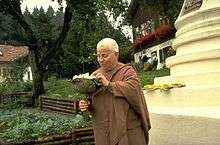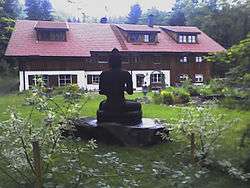Ayya Khema
| Ayya Khema | |
|---|---|
 | |
| Religion | Theravada |
| Personal | |
| Nationality | German & American |
| Born |
Ilse Kussel August 25, 1923 Berlin, Germany |
| Died | November 21, 1997 (aged 74) |
| Senior posting | |
| Title |
bikshuni dasa sil mata |
| Religious career | |
| Teacher |
Ven. Narada Maha Thera (first ordination) Ven. Hsing Yun (second ordination) |
Ayya Khema (August 25, 1923[1] – November 2, 1997) was a Buddhist teacher, and the first Western woman to become a Theravadin Buddhist nun.[2] She was very active in providing opportunities for women to practice Buddhism,[3] founding several centers around the world. In 1987 she coordinated the first ever Sakyadhita International Association of Buddhist Women. Over two dozen books of her transcribed dhamma talks in English and German have been published, and in the last year of her life she also wrote her autobiography: I Give You My Life.
Biography
Born as Ilse Kussel in Berlin, Germany in 1923 to Jewish parents.[1] In 1938, her parents escaped from Germany and traveled to China while plans were made for Khema to join two hundred other children emigrating to Glasgow, Scotland.[4] After two years in Scotland, Khema joined her parents in Shanghai.[5] With the outbreak of the war, Japan conquered Shanghai and the family was moved into the Shanghai Ghetto in Hongkew where her father died five days before the war ended.[6]
At age twenty-two, Khema married a man seventeen years her senior named Johannes and they moved to an apartment in the Hongkou District.[7] In 1947, her first child, a daughter named Irene, was born.[8] As the People's Liberation Army were on the cusp of taking Shanghai, Khema and her family fled for San Francisco, California, United States.[9] From San Francisco, Khema moved to Los Angeles and then San Diego where she gave birth to her second child, a son named Jeffrey.[10]
Soon, Khema began feeling incomplete and this led to investigating various spiritual paths,[11] an interest her husband didn't share.[12] This led to their divorce.[13] Khema moved with her infant son to Rancho La Puerta in Tecate, Mexico to study the philosophy of the Essenes with Professor Edmund Skekely.[14] There she married her second husband, Gerd.[15] The whole family soon became vegetarian, a practice Khema continued until her death.[16]
The three traveled for years, visiting South America, New Zealand, Australia, Pakistan, then settling in Sydney, Australia where Khema began to study with Phra Khantipalo.[17]
To further her studies, Khema traveled to San Francisco to study Zen at the San Francisco Zen Center[17] and worked at Tassajara Zen Mountain Center for three months.[18] She then spent three weeks in Burma where she studied meditation with students of U Ba Khin.[19]
In 1978, Khema founded the Wat Buddha Dhamma forest monastery in New South Wales and installed Phra Khantipalo as abbot.[17]
Khema's desire to become a Buddhist nun led her to Thailand where she studied with Tan Ajahn Singtong for three months.[20] Sri Lanka was her next destination where she met Nyanaponika Thera who introduced her to Narada Maha Thera.[21] Naranda Thera gave her the name "Ayya Khema".[22]
A 1983 return trip to Sri Lanka, led her to meet her teacher, Ven. Matara Sri Ñānarāma of Nissarana Vanaya, who inspired her to teach jhana meditation.[23] As it was not possible at the time to organize an ordination ceremony for bhikkhunis in the Theravada tradition, Ayya Khema then received complete monastic ordination at the newly built Hsi Lai Temple, a Chinese Mahayana temple under the Fo Guang Shan Buddhist Order, in 1988.[24][3]
Khema was one of the organizers of the first International Conference on Buddhist Women in 1987[25] which led to the foundation of the Sakyadhita International Association of Buddhist Women.[26]

In 1989, Khema returned to Germany and began teaching at Buddha Haus in Munich.[27]
According to Ayya Khema's own admission, she had been suffering from breast cancer since 1983. In 1993 after it started giving her trouble she underwent a mastectomy operation in Germany. During a five-week recovery period in the hospital she almost died, but her condition was expeditiously stabilized by the medics. In an interview she expressed a positive opinion of that experience.[28]
| “ | There were two days in the hospital, when I had that feeling, that the energy was leaving, through the feet actually. There was a collapse of the whole system... Losing one's life energy is actually a very pleasant state, because there's less self-assertion, I mean you haven't got the energy to assert yourself. So things are more acceptable, everything is acceptable, it's fine the way it is... One could say that action of dying, if there's no resistance, is extremely pleasant... That seemed to be less and less life energy within the body, and I just was relaxing into that. I was perfectly willing to let it happen, but then these doctors came round... My blood pressure just went way down, waaay down, I mean like almost not happening, and that's when you lose all your energy... It was a very interesting experience and now I can see it's extremely pleasant. It's just letting go and disappearing, and it's very nice. | ” |
Ayya Khema died on November 2, 1997 at Buddha Haus, Uttenbühl (part of the village Oy-Mittelberg) in Germany after a fourteen-year battle with breast cancer.[29] Her ashes are kept in a stupa at Buddha Haus.[27]
Publications
- Being Nobody, Going Nowhere: Meditations on the Buddhist Path, Wisdom Publications, 1987, ISBN 978-0861711987
- When the Iron Eagle Flies: Buddhism for the West, Wisdom Publications, 1991 ISBN 978-0861711697
- Who is myself? A guide to Buddhist meditation (commentary on the Poṭṭhapāda Sutta), Wisdom Publications, 1997, ISBN 978-0861711277
- I Give You My Life (autobiography), Shambhala Publications, 1997, ISBN 978-1570625718
- Come and See for Yourself: The Buddhist Path to Happiness, Windhorse Publications, 1998, ISBN 978-1899579457
- Be an Island: The Buddhist practice of Inner Peace, Wisdom Publications, 1999, ISBN 978-0861711475
- Visible Here and Now: The Buddhist Teachings on the Rewards of Spiritual Practice (commentary on the Samaññaphala Sutta), Shambhala Publications, 2001, ISBN 978-1570624926
- Know Where You're Going: A Complete Buddhist Guide to Meditation, Faith, and Everyday Transcendence (retitled republication of When the Iron Eagle Flies), Wisdom Publications, 2014, ISBN 978-1614291930
See also
References
- Citations
- 1 2 Khema 1998, p. 5.
- ↑ Dowling & Scarlett 2005, p. 118-119.
- 1 2 Keller & Ruether 2006, p. 650.
- ↑ Khema 1998, p. 14.
- ↑ Khema 1998, p. 21-24.
- ↑ Khema 1998, p. 30-34.
- ↑ Khema 1998, p. 35.
- ↑ Khema 1998, p. 36.
- ↑ Khema 1998, p. 37.
- ↑ Khema 1998, p. 40-42.
- ↑ Khema 1998, p. 42-43.
- ↑ Khema 1998, p. 44.
- ↑ Khema 1998, p. 45.
- ↑ Khema 1998, p. 46.
- ↑ Khema 1998, p. 47.
- ↑ Khema 1998, p. 48.
- 1 2 3 Keown & Prebish 2013, p. 444.
- ↑ Khema 1998, p. 130-131.
- ↑ Khema 1998, p. 131-132.
- ↑ Khema 1998, p. 145.
- ↑ Khema 1998, p. 150.
- ↑ Khema 1998, p. 152.
- ↑ Khema 1998, p. 176-177.
- ↑ Khema 1998, p. 181-182.
- ↑ Lopez, Jr. 2002, p. 182.
- ↑ "Brief History of Sakyadhita International". Sakyadhita International Association of Buddhist Women. Retrieved April 21, 2016.
- 1 2 Keown & Prebish 2013, p. 445.
- ↑ Ayya Khema discussion about death with Ann Hershey part 1 YouTube
Ayya Khema discussion about death with Ann Hershey part 2 YouTube - ↑ Friedman 2000, p. 317.
- Bibliography
- Dowling, Elizabeth M.; Scarlett, W. George (2005), Encyclopedia of Religious and Spiritual Development, SAGE Publications, ISBN 9781452265384
- Friedman, Lenore (2000), Meetings with Remarkable Women: Buddhist Teachers in America, Shambhala Publications, ISBN 978-1570624742
- Keller, Rosemary Skinner; Ruether, Rosemary Radford (2006), The Encyclopedia of Women and Religion in North America, Volume 2, Indiana University Press, ISBN 978-0253346872
- Keown, Damien; Prebish, Charles S. (2013), Encyclopedia of Buddhism, Routledge, ISBN 9781136985881
- Khema, Ayya (1998), I Give You My Life, Shambhala Publications, ISBN 1570624151
- Lopez, Jr., Donald S. (2002), A Modern Buddhist Bible: Essential Readings from East and West, Beacon Press, ISBN 9780807012437
External links
- Ayya Khema's writings
- Collection of about 400 of Ayya Khema's Dharma talks between 1988-1996
- "Ayya Khema Talks" another site containing a large number of talks by Ayya Khema
- Practical Guidelines for Vipassanâ
- To Be Seen Here and Now - Ten Dhamma Talks from a meditation retreat at Pelmadulla Bhikkhu Training Centre, Sri Lanka